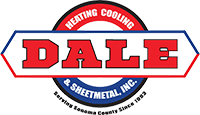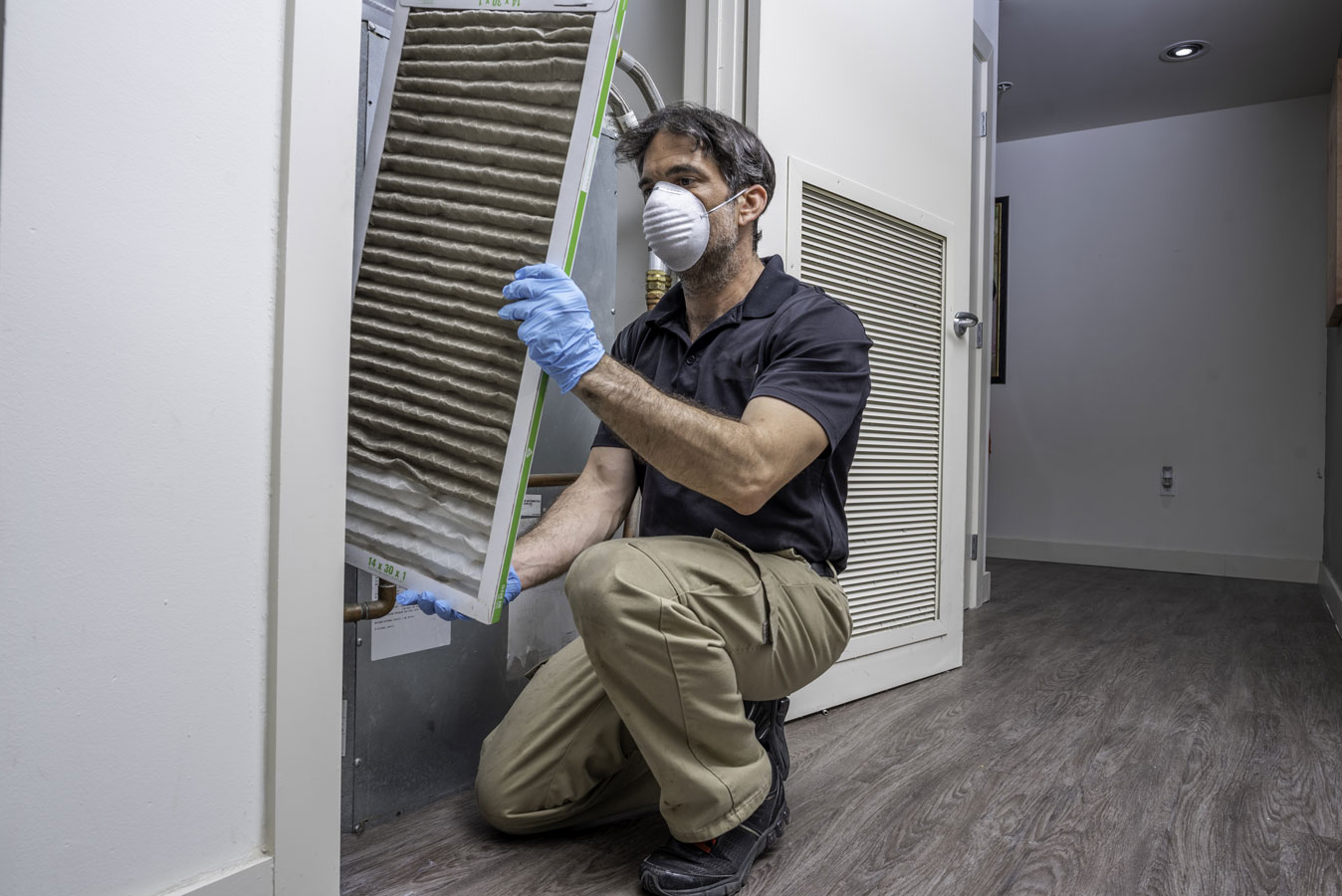Updated: Aug 26, 2025
When winter arrives in Sonoma County, your furnace becomes the unsung hero of your home comfort. But like any hardworking family member, it needs proper care to function at its best.
One of the most common yet overlooked issues affecting furnace performance is a clogged filter. At Dale HCS, we’ve seen firsthand how this simple maintenance item can impact your family’s comfort, energy bills, and even health when neglected.
| Warning Sign | Key Points |
|---|---|
| Reduced Airflow | Weak air from vents, uneven heating throughout home |
| Increased Energy Bills | System works harder, consumes more electricity/gas |
| Poor Indoor Air Quality | More dust, allergies flaring up, visible particles in air |
| Frequent System Cycling | Furnace turns on/off repeatedly, struggles to maintain temperature |
| Unusual Furnace Noises | Straining sounds, whistling from restricted airflow |
Telltale Signs Your Furnace Filter Needs Immediate Attention
A clogged furnace filter might not seem like an urgent problem, but it can quietly damage your heating system while increasing your energy costs. The filter’s job is to trap dust, pet dander, and other airborne particles before they enter your HVAC system. When these filters become clogged, your entire heating system suffers.
According to the Environmental Protection Agency (EPA), indoor air can be two to five times more polluted than outdoor air. A functioning filter is your first line of defense against these pollutants. When clogged, not only does your air quality suffer, but your heating system must work harder to push air through the restricted filter.
Here in Sonoma County, where our weather can fluctuate dramatically between seasons, maintaining proper airflow through your system is essential for consistent comfort. When airflow is restricted due to a clogged filter, you’ll likely notice temperature inconsistencies throughout your home – some rooms may feel perfectly comfortable while others remain chilly no matter how high you set the thermostat.
How to Identify a Clogged Furnace Filter
Recognizing the symptoms of a clogged filter early can save you from costly repairs and uncomfortable living conditions. Most homeowners don’t realize their filter is clogged until they experience one of these common warning signs:
- Visible dust accumulation around your vents and registers, which indicates your filter can no longer trap particles effectively.
- Your furnace runs longer than usual or cycles on and off frequently as it struggles to maintain temperature with reduced airflow.
- Family members experience increased allergy symptoms or respiratory issues while indoors, suggesting poor air filtration.
- Your energy bills have increased without explanation, as your system consumes more power trying to overcome the restriction.
- The filter appears gray, black, or is visibly caked with dust when you check it.
Many homeowners are surprised to learn that a clean filter can improve heating efficiency by 5-15%. This makes regular filter checks one of the most cost-effective ways to lower your heating costs during winter months. For families with pets, allergies, or in dustier environments, filters may need checking monthly rather than quarterly.
Impact of Clogged Filters on Your HVAC System and Family
A clogged filter doesn’t just affect your comfort—it can have serious consequences for both your HVAC equipment and your family’s health. When airflow is restricted, your heating system experiences increased strain. This extra workload can lead to premature wear on components and potentially costly repairs.
- Reduced system lifespan as components like the blower motor work harder to push air through a clogged filter, leading to premature failure.
- Risk of overheating as restricted airflow prevents proper heat dissipation from critical components.
- Frozen evaporator coils in systems that provide both heating and cooling, as inadequate airflow disrupts normal operation.
- Poor indoor air quality that can exacerbate respiratory conditions, allergies, and asthma.
- Higher carbon footprint due to increased energy consumption from an inefficient system.
For families with members who allergies or asthma, maintaining clean filters is particularly crucial. A clogged filter can’t effectively remove allergens like pollen, pet dander, and dust mites from your indoor air. During winter when windows remain closed, these contaminants can build up to concerning levels without proper filtration.
Choosing the Right Filter and Maintenance Schedule
Not all furnace filters are created equal, and selecting the right one for your system and family needs is important. Filters are rated using the MERV (Minimum Efficiency Reporting Value) scale, which ranges from 1-20. For most residential systems, filters with MERV ratings between 8-13 provide excellent filtration without restricting airflow too severely.
Higher MERV ratings (like those found in HEPA filters) capture more particles but may restrict airflow too much for standard residential systems. Before upgrading to a higher-rated filter, consult with an HVAC professional to ensure your system can handle the increased resistance. Some homes may benefit from whole-house air filtration systems that can accommodate higher-efficiency filters without straining the HVAC equipment.
Your filter replacement schedule should be based on several factors specific to your household. While the general recommendation is every 90 days, you might need more frequent changes if you have:
- Pets in the home (especially multiple pets or those that shed heavily)
- Family members with allergies, asthma, or other respiratory conditions
- A home in a dusty area or near construction
- A larger home with more air circulating through the system
During periods of heavy use, like our colder Sonoma County winters, checking your filter monthly is a wise practice. Mark filter changes on your calendar or set reminders on your phone to ensure this simple maintenance task doesn’t slip through the cracks. Some smart thermostats can even remind you when it’s time for a filter change based on system runtime.
How to Properly Replace Your Furnace Filter
Replacing your furnace filter is a simple DIY task that takes just a few minutes but yields significant benefits. First, locate your filter – it’s typically found in the return air duct or at the furnace itself. Turn off your system before removing the old filter to prevent dust from being pulled into the equipment.
When installing the new filter, pay careful attention to the airflow direction arrow printed on the filter frame. Installing a filter backward can severely restrict airflow and damage your system. Once installed, secure any cover or door that houses the filter and restore power to your system.
If you’re unsure about any aspect of filter replacement or HVAC maintenance, our team at Dale HCS is always happy to demonstrate proper techniques during our regular maintenance visits. Professional maintenance remains the best way to ensure your entire system operates efficiently and safely.
When to Call a Professional
While changing filters is straightforward, some situations warrant professional attention. If you’re experiencing persistent heating issues even after replacing your filter, it could indicate more serious problems with your system. Here are signs it’s time to call in the experts:
- Your furnace continues to short-cycle (turn on and off rapidly) even with a clean filter.
- You notice unusual odors like burning smells when your heating system operates.
- Your system makes loud or unusual noises that weren’t present before.
- Airflow remains weak even after installing a new filter.
- Your energy bills continue to climb despite regular filter maintenance.
Our custom fabrication services can also help address unique filtration needs for homes with non-standard HVAC configurations or special air quality requirements. Custom solutions ensure you get optimal filtration without compromising system performance.
Reduced Airflow
Noticeable weak air from vents and uneven room temperatures.
Increased Energy Bills
Higher operating costs due to system overexertion.
Poor Air Quality
Increased dust and allergies from inefficient filtration.
Conclusion: A Simple Step for Significant Benefits
Maintaining clean furnace filters is one of the simplest yet most impactful ways to protect your heating system, improve your home’s air quality, and reduce energy costs. By recognizing the warning signs of a clogged filter and establishing a regular replacement schedule, you’re making an investment in both your family’s comfort and your equipment’s longevity.
Here at Dale HCS, we’ve been serving Sonoma County families for years, and we’ve seen firsthand how this simple maintenance task can prevent many common heating problems during our Northern California winters. If you have questions about choosing the right filter for your system or would like to schedule a comprehensive heating system check-up, contact our team for personalized advice.
As your neighbors and local HVAC experts, we’re committed to helping you maintain a comfortable, efficient home through all seasons. That’s the difference you get with a family-owned business that truly cares about our community’s comfort and wellbeing.

